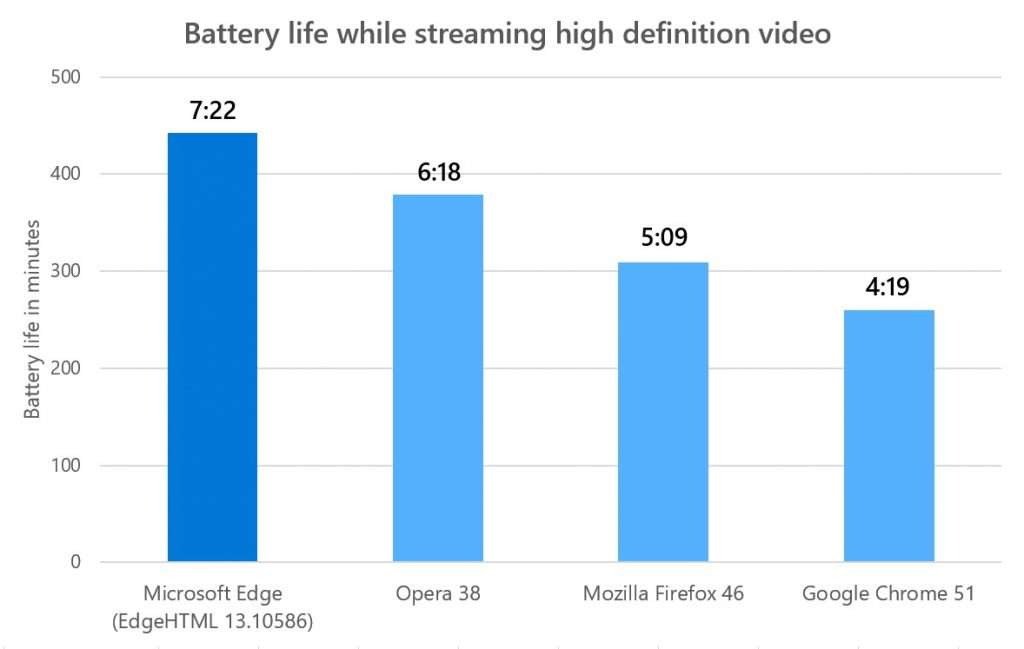Get better quality video with Microsoft Edge
Most Power Efficient Video Playback
As we recently blogged, you get more out of your battery with Microsoft Edge. This time-lapse video test shows Microsoft Edge lasting three hours longer than Google Chrome streaming the same content side by side on identical Surface Book machines. Our results have shown that Microsoft Edge outlasts the rest, delivering 17%-70% more battery life than the competition. Today, we are publishing details on the test methodology that was used and in this post, we’ll dig into the technologies that make Microsoft Edge so much more efficient.

Microsoft Edge has the most power efficient video playback because it was engineered to take advantage of Windows 10 platform features that keep the CPU in low power states during video playback. It does this by offloading CPU intensive video processing operations to power efficient peripheral hardware found in modern PCs and mobile devices. This starts with the use of Microsoft DirectX video acceleration (DXVA) to offload decoding of compressed video. For rendering, Microsoft Edge also works with Multiplane overlay display hardware and sophisticated graphics and UI compositing features to offload video rendering operations. This significantly reduces memory bandwidth required for video processing and compositing at the display.
CPU management in the Windows 10 media stack keeps the CPU running in the lowest power states possible, without compromising UI responsiveness. It is also able to run the display at lower refresh rates during full screen playback of film based content. This saves power by reducing memory bandwidth and improves the quality of film playback by reducing video judder caused by the conversion of the film frame rate (24 Hz, for example) on displays running at 60 Hz. And Microsoft Edge also takes advantage of a feature of the Windows 10 audio stack to offload audio stream processing from the main CPU to dedicated power-efficient audio processing hardware.
Power savings from these features are available to other browsers, but it requires other browser vendors to optimize performance on Windows devices, while Microsoft Edge was designed to provide these power savings innately. And to be clear, the power difference playing higher quality content, like 1080p, becomes even greater. Tight integration with Windows media, graphics, and composition stacks allows Microsoft Edge to render the highest quality content with minimal power draw.
Higher Quality Video
In our video tests, not only was Microsoft Edge the most power efficient, but the premium video site we used also sent higher resolution and bitrate video to Microsoft Edge compared to the other browsers. Here are the details:
| Maximum Resolution | Maximum Bitrate | |
| Microsoft Edge (EdgeHTML 13.10586) | 1080p | 7500 |
| Opera 38 | 720p | 4420 |
| Mozilla Firefox 46 | 720p | 4420 |
| Google Chrome 51 | 720p | 4420 |
The fact that Microsoft Edge received 1080p content in our power test means it actually ran a somewhat higher power draw than it otherwise would have playing 720p content like the other browsers. Microsoft Edge provided the highest quality content and also delivered the longest battery life.
Content owners that stream premium video on the web need to make choices that balance providing the best quality possible, while also ensuring that the content is protected. As quality increases, so does the need for strong Digital Rights Management (DRM), systems that protect media streams so that they can only be played by users authorized by the streaming service. This is important now as companies make decisions to stream 1080p, and will become even more important as video resolutions increase. Content owners will not stream premium content if it can be easily saved and shared outside the service.
Microsoft Edge was built to take advantage of platform features in Windows 10. It is optimized to use PlayReady Content Protection and the media engine’s Protected Media Path, whereas Chrome and Opera implement Widevine, and Firefox implements both Adobe Access and Widevine. Like video decode efficiency, content protection in the platform and closer to the hardware can offer superior performance. Likewise, the better the content protection, the better the video quality the service is likely to provide to that browser.
What Does the Future Hold?
Displays have already moved beyond Full HD/1080p to UltraHD/4K video. Upcoming improvements to audio and video quality go beyond just more audio channels and more pixels. We will see an increase in the number and intensity of colors displayed (color gamut), higher frame rate, high dynamic range (HDR) and broad availability of immersive, spatial or 3-D audio. In the Alliance for Open Media, Microsoft and other leading internet companies are developing next-generation media formats, codecs and other technologies for UltraHD video.
Microsoft is working with industry leading graphics chipset companies to expand support for hardware acceleration of new higher quality content. We are also working with chipset companies to support Enhanced Content Protection that moves the Protected Media Path into peripheral hardware for an even higher level of security. The code running in the peripheral is isolated from the main OS, which provides an increased level of protection, and will likely enable content owners to stream 4k or higher resolution video with confidence. We call the improved security from hardware based DRM “Security Level 3000”.
Chipsets that support hardware based DRM have been shipping in newer PCs. The full support system awaits completion of software components that are coming in Fall of 2016. The Windows 10 platform has significant power and security advantages for media playback available to any application. Paired with the media features built into Windows 10, Microsoft Edge has best-in-class battery life and video playback quality on Windows 10 devices, including PCs, Mobile, Xbox, HoloLens, and other devices.
Let us know what you think over at @MSEdgeDev!


